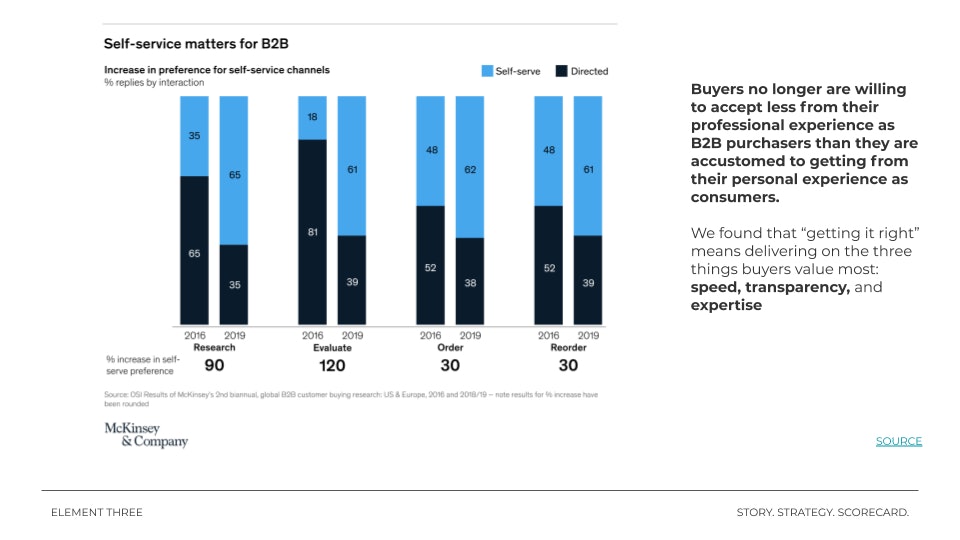2020 was a whirlwind of a year. Pandemic. Social unrest. Political divide. You name it, we all dealt with it this year. While turning the page into 2021 doesn’t quite give us a fresh start with immediate solutions to any of these challenges, it does give each of us a fresh set of goals and responsibilities to accomplish in order to have a successful 2021. At the head of that list should be ensuring your brand position is strong in your marketplace.
For a long time, the most striking brands have existed in the direct-to-consumer space. You don’t often hear of largely business-to-business brands being singled out as the best examples of brands around the world—it’s typically Apple and Nike topping that list. However, as an increasing number of business-to-business buyers work from home, consuming the majority of their content and interacting with companies almost entirely through digital channels, the strength of your brand in business-to-business environments has grown even more important. Here’s why.
Cut through the digital noise
First and foremost, everything is happening as a digital experience now. As your schedule has certainly told you, Zoom usage is up over 100% since the start of COVID quarantines, and overall internet usage has risen by at least 40% when compared to pre-lockdown levels. This consumption is not simply for getting work done, however. The huge uptick in use can be attributed to consumption of entertainment and education in addition to yet another Zoom meeting you’re attending. What does this mean for businesses and marketers? Well, it meant all of the following benefits:
- Increased paid search conversion rates
- Increased video consumption
- Increased traffic to SMBs
- Record high Facebook usage
In summary, it means more people are clicking on your ads, website, and overall digital presence than ever before. It means you have an opportunity to connect with a huge number of buyers and to help your brand stand out.
However, it also means you have more competition than ever.
Marketers are naturally supposed to go where their buyers are. Before the pandemic, some marketers were focused on in-person marketing at trade shows and events. Others were focused on mainly digital channels. Some found results with traditional media. Whatever mix worked best for you, it still was just that—a mix. This allowed brands to find success in different channels with less competition. Following lockdown, the digital channel became the only way to reach your buyer—so marketers did what marketers do and went to meet buyers where they are.
This has muddied the waters, which means your brand needs to be in as strong a position as possible. This doesn’t mean to try and reach every single buyer out there—it means you need to be crystal clear about who you serve, the problems you solve, and why your buyer should trust you over the competition. If you don’t get this right, you’ll simply be lost in the noise—and that noise isn’t going away anytime soon.
ABM is more important than ever
According to Demandbase, investment into account based marketing (ABM) increased 6% from 2019 to 2020 for fully invested teams, and 10% for early stage adopters. For those who do not know what ABM is, essentially it is a sales and marketing strategy that targets specific accounts jointly. Marketing runs campaigns and advertising toward businesses while the sales team targets individuals with personalized outreach.
Here’s the thing: ABM works—if your brand can back it up and provide a strong foundation.
Everyone has been cold called or emailed by a company you’ve never heard about before. How many times have you purchased that product or service? Probably not a lot. I can count on one hand the number of times a truly cold outreach has worked on me.
However, when a brand is consistently in front of you, telling you their story with confident and clear positioning, it gives the cold outreach superpowers. Namely: it turns cold outreach into warm outreach. Consumers are naturally much more willing to hear a salesperson out if they recognize the company name, and even more so if they are already showing signs that the company’s offering would support their goals.
But a weak brand makes your ABM strategy a tough sell, even for our best salespeople. If the position is not clear, your buyer is still going to wonder why the salesperson is even calling them. How are they supposed to help? What does your company actually solve? Most importantly, why should your buyer care? These are all questions your brand can help answer before your sales team even gets involved.
If you really want to super-charge your sales performance, give your sales team the gift of a clear brand position and value to the buyer.
Consumers want a stance, not silence
Regardless of who you sell to, your consumers are demanding that your brand be clear in its values. Also, as Gap clearly showcased with its half blue, half red sweatshirt debacle, trying to play the middle doesn’t work out very well for most brands.
Nor does silence.
Consumers want to buy from brands that align with their own values, and many do research online before making a purchasing decision to decide whether a brand’s values match their own.
Additionally, consumers don’t just want a simple message. They want brands to be bold in their statements. Millennials in particular are calling on—and buying from—brands that make it clear where they stand on issues such as racial injustice and environmental protection.
Does this mean your brand needs to issue a load of public relations-esque statements that you stand for equality and sustainability? No. And unless your actions can back it up, don’t try. Consumers see right through that.
Take an inventory of the strength of your brand. Do your consumers have a clear understanding of your values, and does your marketing display those values in a way other than an About Us page on your website? Do your employees understand and live those values? Does the way you go to market reflect those values? These are hard questions, but ones that must be addressed to build a strong brand foundation for the future.
It’s easy when everyone is winning
Before the pandemic started, the United States was in an eleven-year bull market. Many businesses were achieving record success. It was never easy but it was certainly easier. The good news about the shift in 2020? All the cream rises in tough environments. Those who have been working on brand building took leaps forward in 2020, and that will continue in the future.
Business-to-business buyers increasingly expect the same experience from the brands they buy from professionally as they do from those they buy from individually, according to McKinsey & Company:
This means you have a chance to separate yourself from your competition by creating a defining brand position, and bringing that to life in the way you go to market. Ready to get started?







